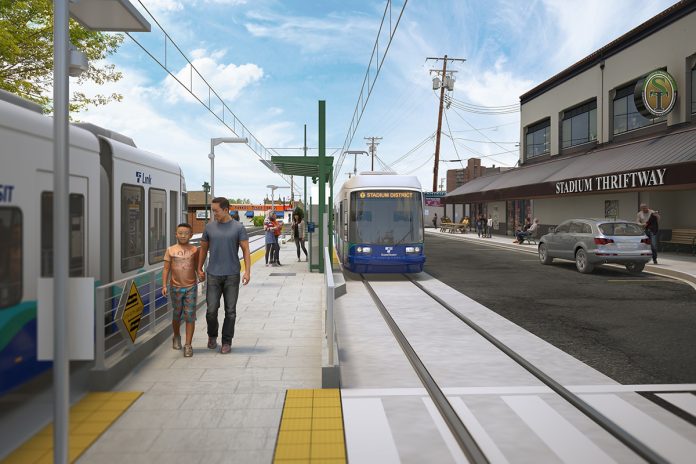
The transit system of the Tacoma area is at a critical juncture. As I have documented in previous articles, should long-range plans advance unmodified, ours will become a degraded transit network at a cost rising into the billions. Major transportation investments will either miss our key centers and corridors, which is a profoundly strange local phenomenon, or create services that are worse than those offered today. The failure to deliver Link light rail to the Tacoma city center — the promised end of the Link Spine for over 20 years—and the loss of a joint Pacific and 6th Avenue transit service, are the most shocking examples. For a city with a proud transit history and an established urban center, these developments are appalling.
All of these misses are exacerbated by Sound Transit’s plans to extend the Hilltop Link Extension streetcar past the hairpin loop that will open in 2023. The representative alignment for continuing the route simply turns the track 90 degrees west and continues it along 19th Avenue.
But there could be relief within our grasp. In a remarkable stroke of luck, a 6th Avenue streetcar extension to Tacoma Community College (TCC) remains legally viable. It requires the rejection of a 19th Street alignment, but the result is a rail transit spine along the city’s premier streets. Should the citizens, relevant commissions, staff, and leadership of the City of Tacoma seek it, the benefits would extend well beyond Tacoma and ensure better transit services for University Place, Fircrest, and the entire RTA regional subarea. While a single transportation project cannot fix all of our recent planning missteps, a 6th Avenue streetcar would significantly mitigate their damage.
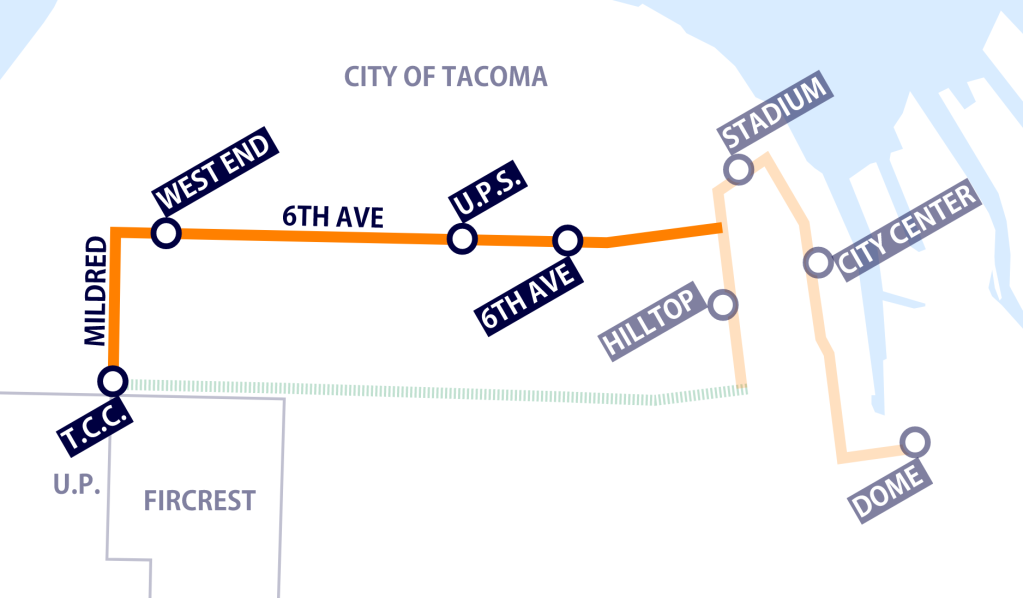
As the update of the One Tacoma Comprehensive Plan is underway before a December 2024 deadline, now is the time to declare a preference for a streetcar extension to TCC utilizing the rights-of-way of 6th Avenue and Mildred Street. Conveniently, the 6th Avenue streetcar is already a feature of the Transportation Master Plan, albeit without priority or a mandate. To properly sponsor it, the update should see the removal of 19th Street and all other corridors as superfluous, with the full weight of the plan coalescing behind a street railway on Pacific Avenue, 6th Avenue, and MLK Way. There is no transit project in the city with as much potential to swing the commute modal split decisively away from cars. Along with bus rapid transit (BRT), these high-performance transit lines would anchor the core of our densifying city.
Since the publishing of my article Transit Trouble is Brewing in Tacoma in November 2022, the 6th Avenue proposal has garnered support. The option was presented to Tacoma’s West End Neighborhood Council, home to TCC, to positive reviews and additional presentations are to come.
While the dismissal of 19th Street for 6th Avenue is a novel idea, the concept of a modern streetcar on 6th Avenue is unquestionably not. Countless citizens have advocated for just such a proposal. In 2013, then-Tacoma councilmember Ryan Mello (since elected to the Pierce County Council) forcefully articulated the value of a 6th Avenue streetcar as a major upgrade of the local transit network (listen at 1:02:50). The sound guidance of Mello and others was ultimately dismissed for reasons less rooted in the development of a successful transit system. Fortunately, the opportunity to construct a street railway along 6th Avenue persists.
Benefits of a 6th Avenue Streetcar
For the college extension, swapping the presumed 19th Street alignment for 6th Avenue would resolve multiple deficiencies in Tacoma’s long-range plans.
It would directly serve the urbanized portions of the city of Tacoma and center a major rail investment in the place where it is most viable. It would deliver high-performance transit to 6th Avenue, a pedestrian-friendly corridor where, incredibly, no substantial transit improvements are identified or slated for funding. The construction of the rail line would be accompanied by a streetscape transformation that would help regulate car traffic and, by law, improve pedestrian access at every intersection, neatly dovetailing with Tacoma’s Vision Zero initiatives. The streetcar line’s associated improvements could be designed in collaboration with the City’s 6th Avenue Pedestrian Crossing Safety Improvement project, an unfunded $5.2 million effort. Along with a revamping of the utility systems underneath, the 6th Avenue streetcar would allow a dense area of Tacoma to prepare for another century of growth.
It would minimize the planning failures of Stream 1 BRT by reconnecting 6th Avenue to all of the downtown core and the regional transit hub at Tacoma Dome. In the process, Pacific Avenue service to a vast swath of the city is restored. In fact, a 6th Avenue streetcar is the natural complement to Stream 1 BRT, fully converting the Route 1 bus line into high-performance transit. It also renders the Market Street deviation more acceptable as a non-rail transit spine through Downtown Tacoma, as more riders would have access to Pacific Avenue without a transfer. It would enhance the existing bus network through service synergy, the byproduct of well-designed systems.
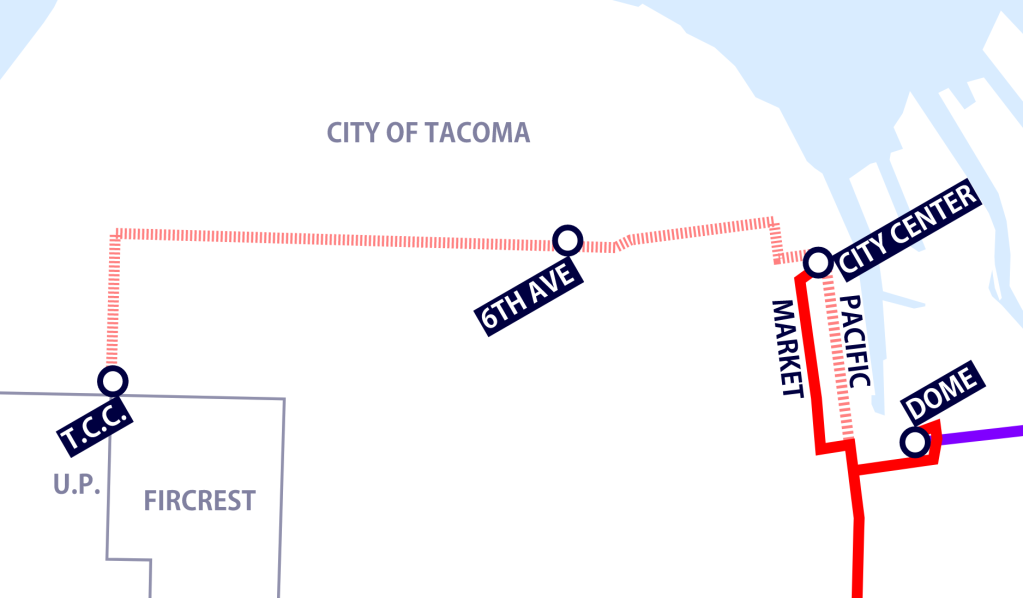
As it already hosts the busiest bus line of Pierce Transit, the Route 1, a 6th Avenue streetcar would be a rail line of regional importance, a better use of Sound Transit funds that are often siphoned from beyond city limits. With regional connections at Tacoma Dome and TCC, Tacoma and neighboring cities would benefit from a street railway system linking the most densely populated, jobs-rich areas of the South Sound, as well as its prominent institutions.
It would allow Pierce Transit to continue to operate the full Route 2, which provides direct service between Downtown Tacoma, TCC, University Place and Lakewood. This is the second busiest route in the Pierce Transit system and it is ripe for upgrades, particularly as the line traverses hills too dangerous for rail service. Should an extension along 19th Street proceed, current planning suggests the Route 2 will be truncated at TCC.
This would impose a transfer penalty on all riders to-and-from Lakewood and University Place, and also grossly extend their commute. A once-direct transit service to Hilltop and downtown would be eliminated, first by a transfer, then by a streetcar line that twists through Hilltop before circling Wright Park (presuming that local bus service on 19th Street is ended, as with Pacific Avenue when BRT opens). While Fircrest would lose one streetcar stop, on Pearl Street, it is not a particularly good one. It certainly is not worth the degradation of the area bus service that would result from a streetcar line on 19th. Fircrest also retains access to the streetcar via TCC, a transfer point made more desirable with 6th Avenue rail service.
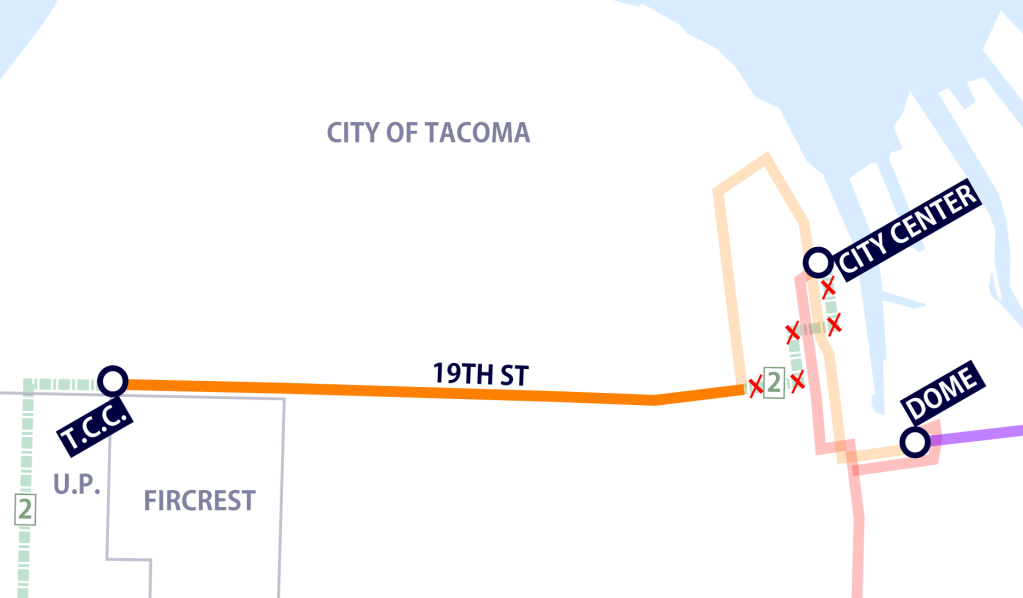
It allows the Stream System Expansion Committee to evaluate Route 2 as a legitimate contender to become the second BRT line, Stream 2. Currently, BRT is noted as being incompatible with long-range streetcar plans along 19th Street, likely resulting in its dismissal as a candidate. Our municipal neighbors should take note.
While it would not bring Link light rail to Downtown Tacoma, it reduces the penalty of the Tacoma Dome transfer by eliminating an outrageous second transfer at Commerce Street. The second transfer is to be imposed upon all 6th Avenue ridership. Transfers at the Dome could be even easier if the Tacoma Dome Link Extension uses Puyallup Avenue (TD1) for its terminal approach — which it should. Most crucially, it would leverage the Hilltop Link Extension (HTLE) investment that is to be opened this year. The HTLE is a peculiar asset. Walking or cycling across its narrow, U-shaped alignment is probably quicker than riding the train. It is a $300 million rail line without a rail precedent. The original rail link to Hilltop was the cable loop that transited residents directly into Downtown Tacoma, a service that buses have retained and improved.
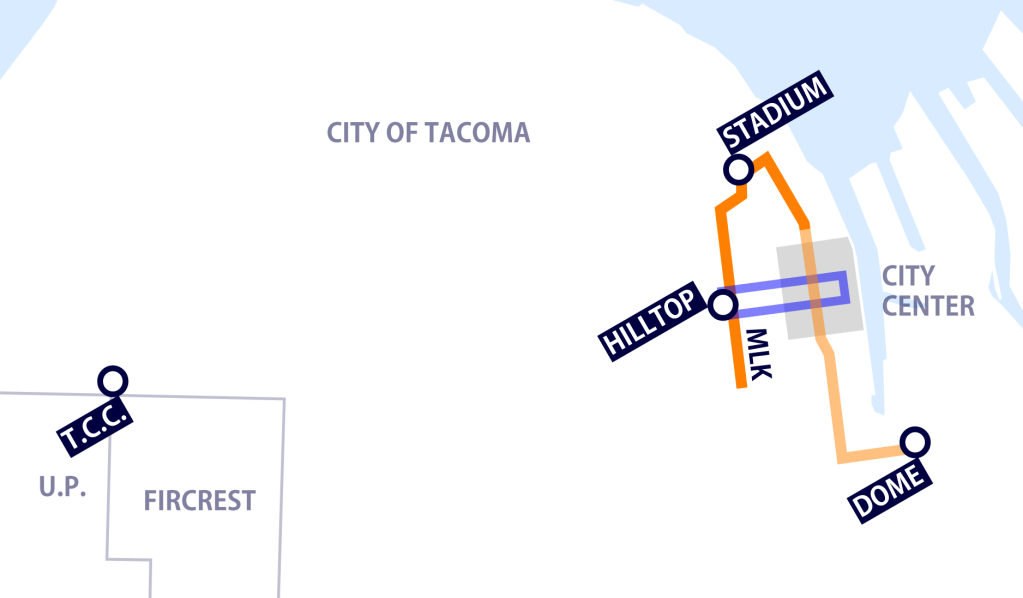
Although an objective of the T Line is to extend to TCC, the HTLE replaces none of the bus lines that today connect Downtown with TCC. The one busline that does partially overlap with the HTLE in Hilltop, Route 57, only moves 150 people a day along MLK Jr. Way and parallel streets. Such a low number does not typically warrant a massive rail investment. By itself, HTLE does not appear to do anything that an upgraded busline could not do, and this comes at a high cost. The cost must be evaluated against a Pierce Transit bus network that is generally starved of resources despite moving the vast majority of transit riders in our area.
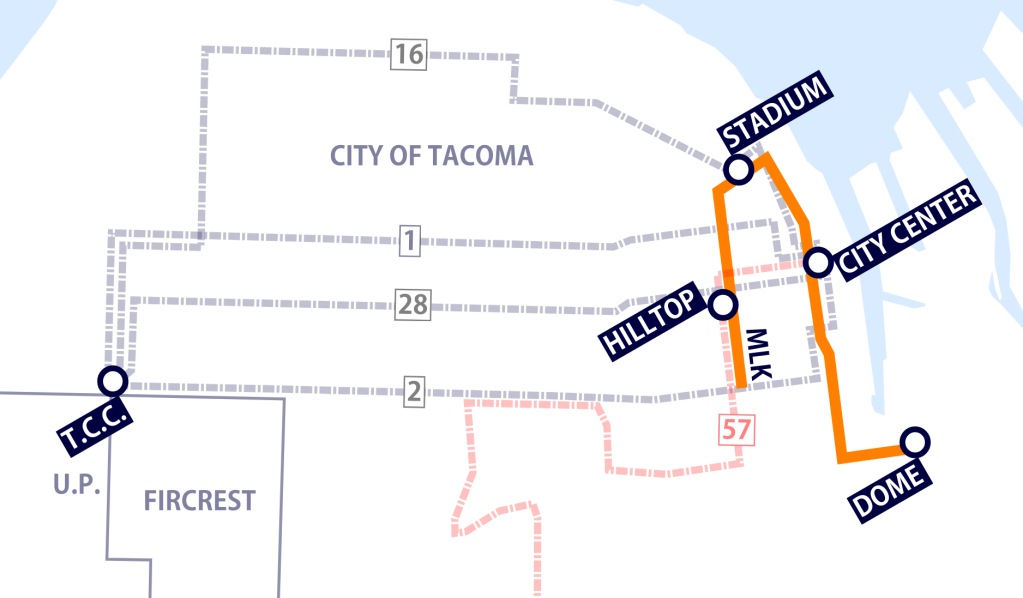
The 6th Avenue streetcar incorporates the HTLE and transforms it into a key segment of a mobility network that effectively serves the people. It serves the Downtown to Hilltop corridor of the HTLE, the foundation of the T Line system (in orange). It retains the Hilltop to TCC service promised to regional voters by ST3, but would do so along the best corridor in this part of the city, 6th Avenue (in blue). The towering benefit is a new and direct Downtown to TCC rail service through the urban heart of the city, linking the college to the regional transit system at the Tacoma Dome via Pacific Avenue (in green). It would be a well-used system with a variety of streetcar services that can be independently adjusted to meet peak demand.
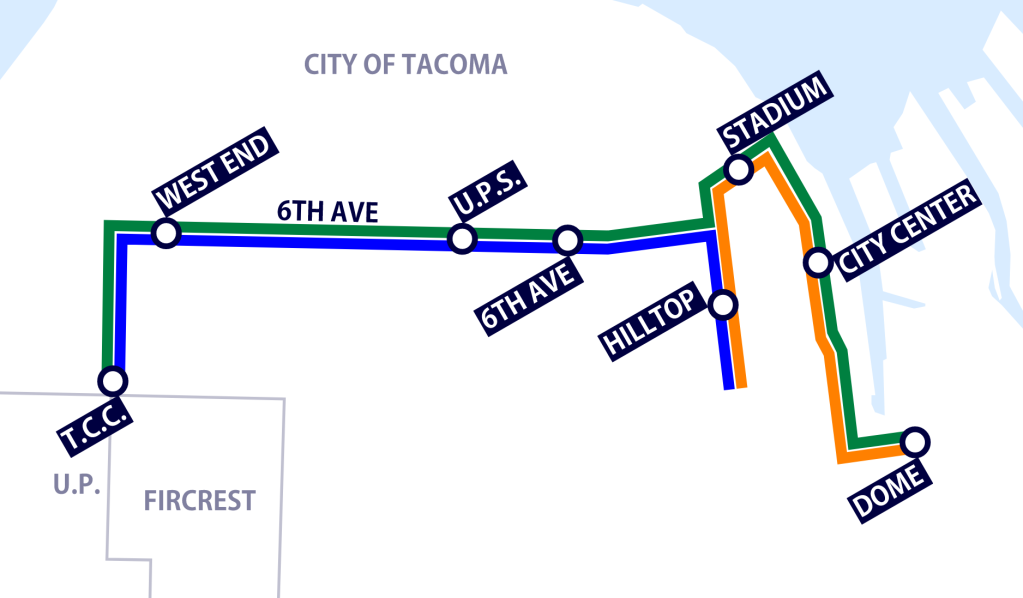
Best of all, the streetcar would fully replace the remaining Route 1 bus line left over from the BRT project. That would allow Pierce Transit to redeploy the bus vehicles and service hours to other deserving corridors in the city.
The 6th Avenue streetcar would have a transformational regional impact.
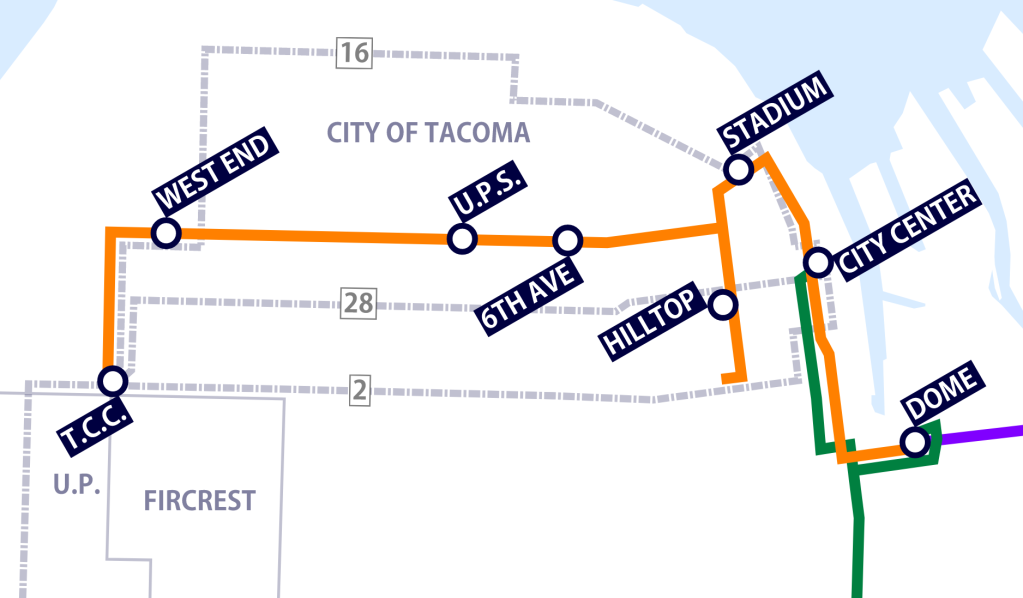
Legal and Technical Feasibility
A 6th Avenue streetcar is both legally and technically feasible.
The legal feasibility of the proposal is the pressing concern. The working assumption is that 19th Street is the required corridor for the T Line extension to TCC, with the thinking that ST3’s passage by the voters compels it. Indeed, certain long-range plans are being developed now with this understanding. However, per Sound Transit itself, 19th Street is not prescribed for the extension, stating:
“South 19th is a representative alignment. It would not require board action for ST staff to study alternative alignments.”
That is, the agency is not legally bound to construct a line using 19th Street and other options are on the table. For a project that will be 40 years in the making and cost a half-billion dollars, the opportunity to serve 6th Avenue by streetcar is tantalizing. With Sound Transit not a barrier to construction, it is the public’s awareness of a 6th Avenue option, or lack thereof, that raises legal concern. The option is not well articulated within any binding plans. Its explicit inclusion into the comprehensive plan update as the exclusive alignment thus warrants deliberation.
The technical feasibility of the proposal is another concern, and whether BRT is more appropriate for serving the corridor.
Being 66-feet at its narrowest and 100-feet at its widest, the right-of-way of 6th Avenue is sufficient to host robust transit infrastructure. These are standard urban widths, if not generous. An inability to utilize them for transit is more a reflection of our unwillingness to confront car dominance than it is any physical limitation of 6th Avenue.
Tramways are the ideal mode of cities that transport masses of people through genuinely constrained corridors, as can be seen in Amsterdam, Toronto, Istanbul and elsewhere. Regardless, the technical feasibility has already been proven. There still exists a generation of people whose lifespans overlap with an operational street railway over 6th Avenue. Any comment of technical infeasibility can be dismissed out-of-hand. They are the opinions of people who do not know how transit systems are designed, nor how they work to serve the commerce and people of a city.
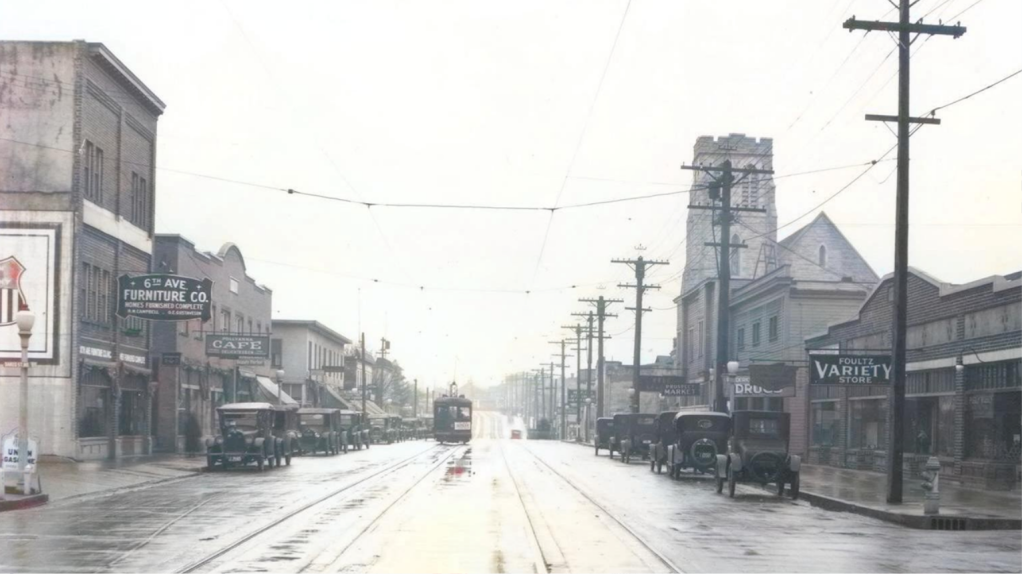
The second concern, of whether BRT is better suited to the task, is more complicated. Buses are an appropriate technology for serving Tacoma. This has been the case since the streetcars were dismantled for them in 1938 to fanfare. The great Tacoma transit mistake was not necessarily the conversion of its street railways to buses, but that it did not retain the trolleywire system above, as Seattle would do a few years later. It is regrettable that buses in Tacoma are not under electric power and quietly serving our city with zero local emissions.
While buslines are practical and more affordable, the manager of the bus system, Pierce Transit, has no intention of providing BRT to 6th Avenue and claims there is little merit to it. They assert right-of-way constraints do not allow for meaningful speed reductions and prevent the use of articulated buses, both of which are disputable. Instead, the agency has proposed upgrades that should already be standard in its system, like transit signal priority on trunk routes. The Route 1 is currently operating with inadequate 30-minute headways. A 6th Avenue BRT line cannot be found within the Pierce Transit 2040 long-range plan, despite the fact that a bus line on 6th Avenue and Mildred Streets, alone, would be the third busiest in the system. It is for these reasons it is presumed that a major bus upgrade is improbable.
Sound Transit’s extension to TCC provides a realistic alternative to Pierce Transit to serve and develop the 6th Avenue corridor. This would presumably require a rail line as that has been the mode identified within every long-range plan and ballot package put before the people. Sound Transit has not yet responded to a question about whether a bus substitution would be legally permissible. If Sound Transit was capable of funding BRT here, it should be seriously considered. Until then, it is presumed that a railway is mandatory, and that the provision of high-performance transit along 6th Avenue will be in the form of a streetcar — if anything at all.
Planning for a 6th Avenue streetcar must begin now
There remains time to prepare for a 6th Avenue streetcar, but its codification through formal plans must begin now. With the update to the One Tacoma Comprehensive Plan underway, the City of Tacoma has an opportunity to do precisely that. The city should take advantage of it, delivering to the public a robust, multi-generational infrastructure.
In Tacoma, there is no other credible transit project that could deliver the mobility transformation promised by a 6th Avenue streetcar. Should the city be truly guided by the six principles of its Transportation Master Plan — being a partner, protecting community, providing mobility for all, striving for sustainability, leveraging programs and strategies, and linking plans to land use — it would move on this proposal.
Read the full, unabridged version of this article on Transportation Matters by clicking here.

